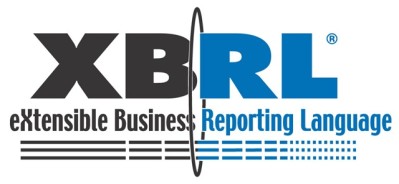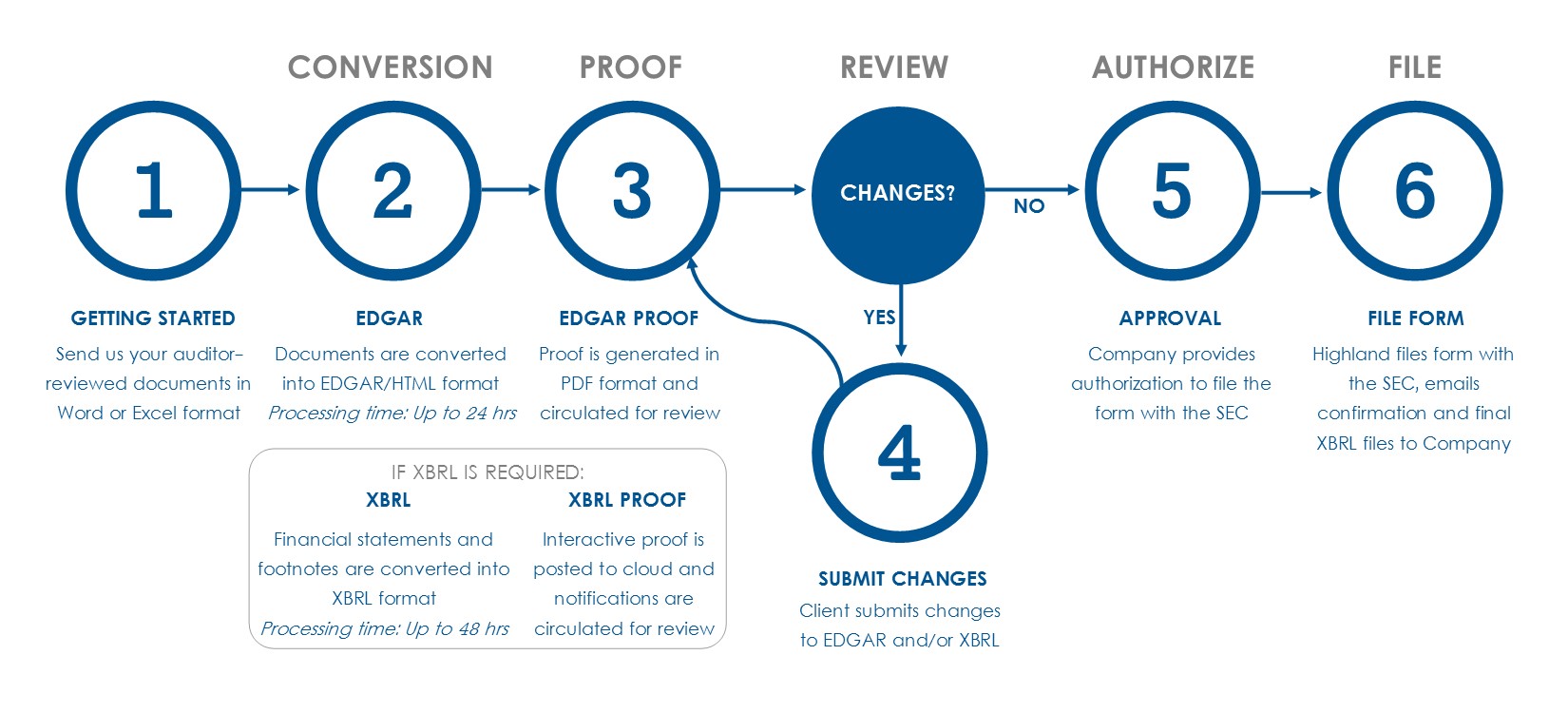 Highland Business Services
Highland Business Services
Trusted Resource for Publicly Traded Companies & Compliance Professionals
REGULATORY FILINGS
COMPLETE EDGAR SERVICES

As a publicly reporting company, you are required by the SEC (Securities and Exchange Commission) to submit your regulatory filings electronically through the EDGAR (Electronic Data-Gathering, Analysis and Retrieval) system.
Why Choose Our EDGAR Conversion and Filing Services?
Our knowledgeable EDGAR filing services team has over a decade of experience, having prepared and filed thousands of regulatory filings with the SEC. You will have the comfort of working with a dedicated account manager who will guide you through the filing process. We can file any form type of any size that is required to be filed on the EDGAR system.
Below is a sampling of the form types that we regularly file with the SEC:
Annual and Quarterly Reports: 10-Q & 10-K
Current Reports: 8-K
Proxy Statements: PRE/DEF 14A & PRE/DEF 14C
Registration Statements: S-1, S-3, S-4, S-8 & S-11
Prospectus: 424B3, 424B4 & 424B5
Regulation A: 1-A, 1-Z, 1-K, 1-SA & 1-U
Foreign Issuers: 20-F, 40-F & 6-K
Ownership Reports: 3, 4, 5 & SC 13D/G
Notice of Upcoming Sale: 144
Investment Management: N-Q, N-PX, N-SAR, N-CSR, SC 13G, 13F, SC 13D & 24F-2
KNOWLEDGEABLE iXBRL SERVICES

In today’s fast-paced financial landscape, precision and compliance are paramount. Our iXBRL tagging services provide you with the accuracy, reliability, and efficiency needed to meet regulatory requirements and present your financial data with confidence.
Why Choose Our iXBRL Tagging Services?
Unmatched Accuracy
Our expert team ensures that every detail of your financial report is accurately tagged, reducing the risk of errors and non-compliance.
Regulatory Compliance:
Stay ahead of regulatory changes with our up-to-date knowledge and adherence to the latest iXBRL standards and guidelines.
Time and Cost Efficiency:
Save valuable time and resources with our streamlined tagging process, allowing your team to focus on core business activities.
Comprehensive Support:
From initial consultation to final submission, our dedicated support team is with you every step of the way, ensuring a smooth and hassle-free experience.
Join the Growing List of Satisfied Clients
Partner with us to experience the seamless integration of advanced technology and expert knowledge in your financial reporting. Our commitment to excellence and client satisfaction sets us apart in the industry.
Ready to transform your financial reporting? Contact us today for a consultation and discover how our iXBRL tagging services can benefit your organization.
THE FILING PROCESS FROM START TO FINISH

If you haven’t filed before, you will need to receive filing codes from the SEC. Every filer needs a CIK code (which identifies the filer) and a CCC code (for security). A Form ID will need to be completed, notarized, and submitted to the SEC. Highland can assist you in obtaining these codes.
We typically receive the documents in Word and Excel format. We also accept PDFs for certain filings. We’ll send you a proof of the converted document so you can verify the layout, formatting and content before it is filed. Once you’ve approved, we will do a test file first with the SEC to make sure it will be accepted before the live file is sent. We will e-mail you the confirmation once the filing has been accepted by the SEC. Also, to make your next filing even easier, we can send you back your old converted document in Word format so you can use it as a template next time.
DOWNLOAD OUR 2024 FILING CALENDAR
Our printable calendar of filing deadlines and SEC holidays is a valuable resource to help keep you on track for your reporting requirements.
Frequently Asked Questions
You must pay filing fees when you submit most registration statements under the Securities Act of 1933, transaction filings such as merger proxy statements under the Securities Exchange Act of 1934, and applications on Form T-3 under the Trust Indenture Act of 1939. You do not pay an initial registration fee for mutual fund and unit investment trust registration statements, but you pay fees each year when you file your Form 24F-2.
If your filing is fee bearing and adequate funds are not available in your account, the filing will eventually be suspended. Fees are charged for fee bearing filings regardless of the type of tool used to construct your filing.
Note: When you transmit a test submission, EDGAR checks your U.S. Bank fee deposit and informs you if you are lacking your fees.
Filings that Require Filing Fees
1933 Act Filings by Corporations
You must pay a filing fee with the following 1933 Act filings:
S-1, S-2, S-3, S-3D, S-4, S-4EF, S-8, S-11, SB-1, SB-2, S-20, F-1, F-2, F-2D, F-3, F-3D, F-4, F-6, F-6EF, SF-1, SF-3MEF
You also must pay a fee with all rule 462(b) filings – form types with a “MEF ” suffix. You will be required to pay a filing fee on pre-effective amendments to registration statements (e.g., S-1/A) if additional securities are being registered in the amendment. Since you cannot register additional securities by post-effective amendment, no fee is required for these filings (e.g., S-8POS).
1934 Act Filings
You must pay a filing fee with the following 1934 Act filings:
SC TO-T, SC TO-I, SC 13E-3, SC13E4F, SC14D1F
A fee is sometimes required for the following 1934 Act Filings:
PREM14A, PREM14C, PRER14A, PRER14C, SC 13E1
1933 and 1940 Act Filings by Investment Companies
You must pay a filing fee with the following EDGAR submissions made by investment companies:
24F-2NT, N-2, N-5, N-14 8C, N-14MEF
[Obtained from the SEC’s EDGAR Filer Management website]
Your registration fee is calculated based on the proposed public offering of shares of common stock. The current fee is $147.60 per $1,000,000. (Information obtained from https://www.sec.gov/ofm/Article/feeamt.html)
Where to Pay Filing Fees
Visit the Filing Fees Branch for payment options for your registration fees.
For data users, Inline XBRL provides an easier way to view, access, and explore the contextual information of the underlying data. For example, users can click on individual tagged data points in the filing to find more information about the data, such as citations and hyperlinks to the relevant accounting guidance, narrative definitions for the values, and reporting period information associated with each value.
You will receive five codes from the SEC when you submit your Form ID request. Each code serves a different, important purpose:
CIK (Central Index Key) – This is a unique code assigned by the SEC which identifies your company to the SEC. This code is searchable on EDGAR and is available to the public.
CCC (CIK Confirmation Code) – This code, along with the CIK number, is used to submit your filings. This code is confidential and NOT available to the public.
Password – This is a unique confidential code used along with the CIK number to access EDGAR. This code expires annually.
PMAC (Password Modification Authorization Code) – This code is used to authorize a change of password and is extremely confidential.
Passphrase – This security code is used along with the CIK to regenerate new EDGAR Access Codes if needed.
If you’ve already registered with the SEC, but no longer have your filing codes, please let us know. If you have some information (passphrase, password, etc.), we can use that to generate new codes. Otherwise, we can request a new set of codes using your CIK number alone. We will provide you with a form to be notarized and faxed to the SEC.
If you haven’t registered with the SEC yet, we can also help you obtain your filing codes by filing a Form ID. Please contact us today to get started.
You must complete a 12b-25 (Notice of Late Filing) which is due one business day following the original filing due date.This will allow for an additional 5-15 calendar days from the date the filing was originally due depending on the type of filing. A template for the 12b-25 can be accessed on the FORMS tab.
You can email your documents to us at [email protected]. We have provided Word templates for many of the common SEC form types on the FORMS tab for your convenience. We prefer documents to be provided in Microsoft Word and Excel format. We can convert from PDF as well, but it requires additional labor and time to complete.
Depending on size and volume, we can typically EDGARize and return your documents to you the same day they are received. iXBRL filings typically take up to 36-48 hours to prepare. If you have an urgent deadline, please make sure to communicate that to us so we can ensure your document is returned ASAP.
We will send you a confirmation email from the SEC once your filing has been accepted. Visit our HOW IT WORKS tab for more information.
10-Q’s must be filed within 45 days from fiscal quarter end for non-accelerated filers and within 40 days for accelerated filers. 10-K’s must be filed within 90 days from fiscal year end for non-accelerated filers and within 75 days for accelerated filers. See our FILING CALENDAR for more information.
We accept check, credit card, wire transfers and online payments using your U.S. bank account. We offer additional discounts for clients that prepay their EDGAR fees.
While the SEC had previously required that XBRL files were posted on the registrant’s website, they have eliminated the website-posting requirement for iXBRL filings.
More Questions?
Contact Info
Highland Business Services, Inc.8194 W. Deer Valley Rd., Suite 106-204
Peoria, AZ 85382
Phone:(602) 375-0888 Toll Free: (800) 875-2980
Email: [email protected]
Business Hours
-
- Monday-Friday: 8am to 5pm
- Extended weekday hours and weekend hours during peak filing periods and upon demand